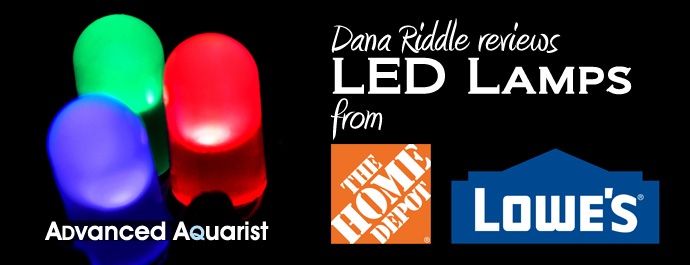
Light-emitting diodes (LEDs) have come a long way since simply being used as an on/off indicator on coffee makers. Technical improvements have boosted their light outputs, making them usable as automotive headlamps, street lamps, area lighting, and, naturally enough, aquaria lighting.
I first tested a LED array for possible aquarium use in 2000, and submitted the results for publication. That article was rejected on the grounds that cutting-edge technologies of that time (metal halide and fluorescent lamps) were just fine, and there was no need to consider ‘wild-hair’ lighting thank you very much! A few years later, I would test the first commercially-available LED unit specifically designed for aquarium use (PFO’s Solaris.) This creating quite a bit of controversy with some rabidly vocalizing their disdain for this ‘new’ technology.
Today, one would be hard pressed to see anything but LEDs being used while making the rounds of a local frag swap or reef aquarium tour, and light-emitting diodes are firmly accepted. And with this acceptance, prices have fallen dramatically. It would only be a matter of time before novelty LED lamps would make their way into product inventories of retailing giants such as Home Depot and others.
This article will examine the spectral characteristics and light intensity of 7 lamps I recently purchased at the local Lowe’s and Home Depot home improvement stores. These are a 5000K LED made by Cree, Incorporated (Durham, North Carolina), a ‘blue’ one made by Philips Lighting North America (Somerset, New Jersey), green by Feit Electric (Pico Rivera, California), and several (purple, yellow, and red) marketed by Home Depot (Atlanta, Georgia), and an interesting remote-controllable lamp capable of producing 15 different colors (Crayola, Easton, Pennsylvania.) All have a E26 medium mogul base, making them compatible with almost all lighting fixtures that accept standard incandescent or mogul-base compact fluorescent lamps. Prices of the Home Depot and Lowes’ lamps (Hawaii prices) are about $7.00 each while the Crayola 16-color, remote control lamp is about $10. Since prices are low and availability shouldn’t be much of an issue, use of these lamps could make for some interesting DIY projects.
Are the spectral characteristics suitable for illuminating planted or reef aquaria? Do they produce enough light?
The Lamps
We’ll begin our observations with results of testing performed on the Philips’ blue LED lamp.
Philips Blue:
- Advertised Wattage: 8
- Measured Wattage: 7.5
- Peak Wavelength: 449 nm
- Dimmable: No
- Manufacturer: Philips Lighting North America
Upon first seeing this lamp, I wondered if its blue housing was simply a marketing device to make recognition easy, or if the blue globe filtered a broad bandwidth to make it appear blue. Although I can’t speak for Philips’ marketing personnel, it would be apparent upon completion of testing that the LEDs contained in this lamp do produce more than just blue light although wavelengths of 400 – 510 nm compose about 77% of emitted light.
Table 1. Spectral components of the blue LED.
| Color | Percent |
|---|---|
| Violet (400 – 430 nm) | 2% |
| Blue (431 – 480 nm) | 58% |
| Green-Blue (481 – 490 nm) | 6% |
| Blue-Green (491 – 510 nm) | 11% |
| Green (511 – 530 nm) | 8% |
| Yellow-Green (531 – 570 nm) | 7% |
| Yellow (571 – 580 nm) | 1% |
| Orange (581 – 600 nm) | 1% |
| Red (601 – 700 nm) | 5% |
Purple:
- Advertised Wattage: n/a
- Measured Wattage: 2.7
- Peak Wavelength: 456 nm
- Dimmable: No
- Manufacturer: Ecosmart, distributed by Home Depot
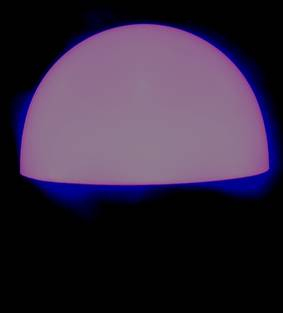
Figure 4. As with the other LEDs distributed by Home Depot and reviewed in this article (purple, yellow, and red) the light-emitting portion is half-globe.
Color perception can vary among individuals. To compound the issue, violet light is often confused with purple light – the former being a pure color, while purple is a combination of red and blue light. I could not tell by simply looking at the light emitted by this device exactly what color it truly was. Testing revealed very little violet light was produced, and the light is properly marketed as ‘purple’ since its output is a combination of blue (66%) and red (12%) with the remainder scattered among 7 other bandwidths.
| Color | Percent |
|---|---|
| Violet (400 – 430 nm) | 2% |
| Blue (431 – 480 nm) | 66% |
| Green-Blue (481 – 490 nm) | 4% |
| Blue-Green (491 – 510 nm) | 3% |
| Green (511 – 530 nm) | 1% |
| Yellow-Green (531 – 570 nm) | 5% |
| Yellow (571 – 580 nm) | 2% |
| Orange (581 – 600 nm) | 5% |
| Red (601 – 700 nm) | 12% |
Yellow:
- Advertised Wattage: n/a
- Measured Wattage: 2.1
- Peak Wavelength: 596 nm
- Dimmable: No
- Manufacturer: Ecosmart, distributed by Home Depot
To my eye, this lamp appears yellow although most of the emitted light is in the orange portion of the spectrum.
| Color | Percent |
|---|---|
| Violet (400 – 430 nm) | 1% |
| Blue (431 – 480 nm) | 1% |
| Green-Blue (481 – 490 nm) | 0% |
| Blue-Green (491 – 510 nm) | 1% |
| Green (511 – 530 nm) | 1% |
| Yellow-Green (531 – 570 nm) | 4% |
| Yellow (571 – 580 nm) | 7% |
| Orange (581 – 600 nm) | 66% |
| Red (601 – 700 nm) | 19% |
Red:
- Advertised Wattage: n/a
- Measured Wattage: 2.9
- Peak Wavelength: 630 nm
- Dimmable: No
- Manufacturer: Ecosmart, distributed by Home Depot
There is truth in advertising – this lamp produced light almost entirely in the red portion of the spectrum.
| Color | Percent |
|---|---|
| Violet (400 – 430 nm) | 1% |
| Blue (431 – 480 nm) | 1% |
| Green-Blue (481 – 490 nm) | 0% |
| Blue-Green (491 – 510 nm) | 1% |
| Green (511 – 530 nm) | 1% |
| Yellow-Green (531 – 570 nm) | 1% |
| Yellow (571 – 580 nm) | 1% |
| Orange (581 – 600 nm) | 3% |
| Red (601 – 700 nm) | 91% |
Daylight (5000K):
- Advertised Wattage: 10
- Measured Wattage: 10.1
- Peak Wavelength: 543 nm
- Major Shoulder Wavelengths: 450nm; 580 nm
- Advertised CRI: 83
- Dimmable: Yes
- Manufacturer: Cree, Incorporated
| Color | Percent |
|---|---|
| Violet (400 – 430 nm) | 1% |
| Blue (431 – 480 nm) | 17% |
| Green-Blue (481 – 490 nm) | 3% |
| Blue-Green (491 – 510 nm) | 8% |
| Green (511 – 530 nm) | 11% |
| Yellow-Green (531 – 570 nm) | 23% |
| Yellow (571 – 580 nm) | 5% |
| Orange (581 – 600 nm) | 9% |
| Red (601 – 700 nm) | 22% |
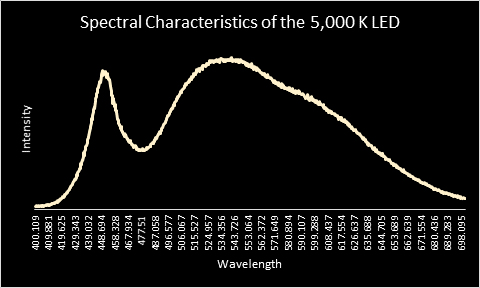
Figure 15. Blue light made by this LED peaks at about 450 nm, but a blend of phosphors makes white light.
Crayola’s 16 Color LED Lamp:
- Advertised Wattage: 3
- Measured Wattage: 0.4 to 1.7
- Dimmable: Yes
- Manufacturer: Interek for Crayola, distributed by Lowe’s
For the do-it-yourselfer, this lamp offers some interesting possibilities. First, it is capable of producing 16 distinct colors, if only one at a time. Further, it is dimmable (in four steps – ‘low’, ‘medium’, ‘high’ and ‘very high’) through use of a remote control device. Though of limited interest to aquarists, it can cycle through all colors in ‘smooth’ and ‘strobe’ modes.
Crayola’s Multi-Color LED Remote Controller:
The hand-held controller offers various functions. It can turn the lamp on and off, dim the lamp in four steps, choose among 16 colors, ‘flash’ mode cycles the lamp through its colors in 1 second intervals, ‘fade’ mode ramps lamp intensity from high to low in four seconds and then changes color and repeats, ‘strobe’ mode acts as ‘fade’ mode does, but intensity is ramped incrementally in 3 second cycles. Although the directions state ‘smooth’ modes alternates color in 5 second intervals, my remote simply repeated ‘flash’ mode. Four wattages are listed for each Crayola color – one for each power setting.
We’ll now examine the different colors this lamp can produce and their respective intensities.
Crayola Red:
- Peak Wavelength: 629 nm
- Advertised Wattage: 3
- Measured Wattage: 0.4/0.5/0.6/0.8
- Dimmable: Yes
- Manufacturer: Interek for Crayola, distributed by Lowe’s
| Color | Percent |
|---|---|
| Violet (400 – 430 nm) | 2% |
| Blue (431 – 480 nm) | 3% |
| Green-Blue (481 – 490 nm) | 1% |
| Blue-Green (491 – 510 nm) | 1% |
| Green (511 – 530 nm) | 1% |
| Yellow-Green (531 – 570 nm) | 3% |
| Yellow (571 – 580 nm) | 1% |
| Orange (581 – 600 nm) | 4% |
| Red (601 – 700 nm) | 85% |
Crayola Orange-Red:
- Peak Wavelength: 630 nm
- Advertised Wattage: 3
- Measured Wattage: 0.4/0.5/0.6/0.9
- Dimmable: Yes
- Manufacturer: Interek for Crayola, distributed by Lowe’s
| Color | Percent |
|---|---|
| Violet (400 – 430 nm) | 1% |
| Blue (431 – 480 nm) | 3% |
| Green-Blue (481 – 490 nm) | 1% |
| Blue-Green (491 – 510 nm) | 3% |
| Green (511 – 530 nm) | 6% |
| Yellow-Green (531 – 570 nm) | 6% |
| Yellow (571 – 580 nm) | 1% |
| Orange (581 – 600 nm) | 3% |
| Red (601 – 700 nm) | 76% |
Crayola Dark Orange:
- Peak Wavelength: 630 nm
- Advertised Wattage: 3
- Measured Wattage: 0.4/0.5/0.6/1.0
- Dimmable: Yes
- Manufacturer: Interek for Crayola, distributed by Lowe’s
| Color | Percent |
|---|---|
| Violet (400 – 430 nm) | 1% |
| Blue (431 – 480 nm) | 2% |
| Green-Blue (481 – 490 nm) | 1% |
| Blue-Green (491 – 510 nm) | 4% |
| Green (511 – 530 nm) | 10% |
| Yellow-Green (531 – 570 nm) | 10% |
| Yellow (571 – 580 nm) | 1% |
| Orange (581 – 600 nm) | 3% |
| Red (601 – 700 nm) | 67% |
Crayola Light Orange:
- Peak Wavelength: 630 nm
- Advertised Wattage: 3
- Measured Wattage: 0.5/0.6/0.9/1.1
- Dimmable: Yes
- Manufacturer: Interek for Crayola, distributed by Lowe’s
| Color | Percent |
|---|---|
| Violet (400 – 430 nm) | 1% |
| Blue (431 – 480 nm) | 2% |
| Green-Blue (481 – 490 nm) | 1% |
| Blue-Green (491 – 510 nm) | 6% |
| Green (511 – 530 nm) | 17% |
| Yellow-Green (531 – 570 nm) | 15% |
| Yellow (571 – 580 nm) | 1% |
| Orange (581 – 600 nm) | 3% |
| Red (601 – 700 nm) | 55% |
Crayola Yellow-Green:
- Peak Wavelength: 630 nm
- Advertised Wattage: 3
- Measured Wattage: 0.5/0.7/0.9/1.5
- Dimmable: Yes
- Manufacturer: Interek for Crayola, distributed by Lowe’s
| Color | Percent |
|---|---|
| Violet (400 – 430 nm) | 1% |
| Blue (431 – 480 nm) | 2% |
| Green-Blue (481 – 490 nm) | 1% |
| Blue-Green (491 – 510 nm) | 9% |
| Green (511 – 530 nm) | 24% |
| Yellow-Green (531 – 570 nm) | 20% |
| Yellow (571 – 580 nm) | 1% |
| Orange (581 – 600 nm) | 2% |
| Red (601 – 700 nm) | 39% |
Crayola Dark Green:
- Peak Wavelength: 525 nm
- Advertised Wattage: 3
- Measured Wattage: 0.4/0.5/0.6/0.9
- Dimmable: Yes
- Manufacturer: Interek for Crayola, distributed by Lowe’s
| Color | Percent |
|---|---|
| Violet (400 – 430 nm) | 1% |
| Blue (431 – 480 nm) | 3% |
| Green-Blue (481 – 490 nm) | 2% |
| Blue-Green (491 – 510 nm) | 13% |
| Green (511 – 530 nm) | 39% |
| Yellow-Green (531 – 570 nm) | 33% |
| Yellow (571 – 580 nm) | 2% |
| Orange (581 – 600 nm) | 2% |
| Red (601 – 700 nm) | 5% |
Crayola Light Green:
- Peak Wavelength: 526 nm
- Advertised Wattage: 3
- Measured Wattage: 0.5/0.5/0.6/0.9
- Dimmable: Yes
- Manufacturer: Interek for Crayola, distributed by Lowe’s
| Color | Percent |
|---|---|
| Violet (400 – 430 nm) | 1% |
| Blue (431 – 480 nm) | 14% |
| Green-Blue (481 – 490 nm) | 2% |
| Blue-Green (491 – 510 nm) | 12% |
| Green (511 – 530 nm) | 34% |
| Yellow-Green (531 – 570 nm) | 29% |
| Yellow (571 – 580 nm) | 1% |
| Orange (581 – 600 nm) | 2% |
| Red (601 – 700 nm) | 5% |
Crayola Sky Blue:
- Peak Wavelength: 526 nm
- Advertised Wattage: 3
- Measured Wattage: 0.5/0.6/0.7/0.9
- Dimmable: Yes
- Manufacturer: Interek for Crayola, distributed by Lowe’s
| Color | Percent |
|---|---|
| Violet (400 – 430 nm) | 1% |
| Blue (431 – 480 nm) | 22% |
| Green-Blue (481 – 490 nm) | 3% |
| Blue-Green (491 – 510 nm) | 11% |
| Green (511 – 530 nm) | 30% |
| Yellow-Green (531 – 570 nm) | 25% |
| Yellow (571 – 580 nm) | 1% |
| Orange (581 – 600 nm) | 1% |
| Red (601 – 700 nm) | 4% |
Crayola Light Blue:
- Peak Wavelength: 460 nm
- Advertised Wattage: 3
- Measured Wattage: 0.5/0.6/0.8/1.2
- Dimmable: Yes
- Manufacturer: Interek for Crayola, distributed by Lowe’s
| Color | Percent |
|---|---|
| Violet (400 – 430 nm) | 1% |
| Blue (431 – 480 nm) | 34% |
| Green-Blue (481 – 490 nm) | 4% |
| Blue-Green (491 – 510 nm) | 10% |
| Green (511 – 530 nm) | 25% |
| Yellow-Green (531 – 570 nm) | 21% |
| Yellow (571 – 580 nm) | 1% |
| Orange (581 – 600 nm) | 1% |
| Red (601 – 700 nm) | 3% |
Crayola Blue:
- Peak Wavelength: 460 nm
- Advertised Wattage: 3
- Measured Wattage: 0.6/0.7/0.9/1.7
- Dimmable: Yes
- Manufacturer: Interek for Crayola, distributed by Lowe’s
| Color | Percent |
|---|---|
| Violet (400 – 430 nm) | 2% |
| Blue (431 – 480 nm) | 48% |
| Green-Blue (481 – 490 nm) | 5% |
| Blue-Green (491 – 510 nm) | 9% |
| Green (511 – 530 nm) | 18% |
| Yellow-Green (531 – 570 nm) | 15% |
| Yellow (571 – 580 nm) | 1% |
| Orange (581 – 600 nm) | 1% |
| Red (601 – 700 nm) | 3% |
Crayola Dark Blue:
- Peak Wavelength: 460 nm
- Advertised Wattage: 3
- Measured Wattage: 0.4/0.5/0.7/1.0
- Dimmable: Yes
- Manufacturer: Interek for Crayola, distributed by Lowe’s
| Color | Percent |
|---|---|
| Violet (400 – 430 nm) | 3% |
| Blue (431 – 480 nm) | 75% |
| Green-Blue (481 – 490 nm) | 6% |
| Blue-Green (491 – 510 nm) | 4% |
| Green (511 – 530 nm) | 2% |
| Yellow-Green (531 – 570 nm) | 3% |
| Yellow (571 – 580 nm) | 1% |
| Orange (581 – 600 nm) | 1% |
| Red (601 – 700 nm) | 5% |
Crayola Deep Blue:
- Peak Wavelength: 460 nm
- Advertised Wattage: 3
- Measured Wattage: 0.5/0.5/0.7/1.0
- Dimmable: Yes
- Manufacturer: Interek for Crayola, distributed by Lowe’s
| Color | Percent |
|---|---|
| Violet (400 – 430 nm) | 3% |
| Blue (431 – 480 nm) | 72% |
| Green-Blue (481 – 490 nm) | 6% |
| Blue-Green (491 – 510 nm) | 4% |
| Green (511 – 530 nm) | 2% |
| Yellow-Green (531 – 570 nm) | 2% |
| Yellow (571 – 580 nm) | 1% |
| Orange (581 – 600 nm) | 1% |
| Red (601 – 700 nm) | 10% |
Crayola Ultra Blue:
- Peak Wavelength: 460 nm
- Advertised Wattage: 3
- Measured Wattage: 0.5/0.6/0.7/1.1
- Dimmable: Yes
- Manufacturer: Interek for Crayola, distributed by Lowe’s
| Color | Percent |
|---|---|
| Violet (400 – 430 nm) | 2% |
| Blue (431 – 480 nm) | 68% |
| Green-Blue (481 – 490 nm) | 6% |
| Blue-Green (491 – 510 nm) | 4% |
| Green (511 – 530 nm) | 2% |
| Yellow-Green (531 – 570 nm) | 2% |
| Yellow (571 – 580 nm) | 1% |
| Orange (581 – 600 nm) | 1% |
| Red (601 – 700 nm) | 14% |
Crayola Purple:
- Peak Wavelength: 460 nm
- Advertised Wattage: 3
- Measured Wattage: 0.5/0.6/0.7/1.3
- Dimmable: Yes
- Manufacturer: Interek for Crayola, distributed by Lowe’s
| Color | Percent |
|---|---|
| Violet (400 – 430 nm) | 2% |
| Blue (431 – 480 nm) | 63% |
| Green-Blue (481 – 490 nm) | 5% |
| Blue-Green (491 – 510 nm) | 4% |
| Green (511 – 530 nm) | 1% |
| Yellow-Green (531 – 570 nm) | 2% |
| Yellow (571 – 580 nm) | 1% |
| Orange (581 – 600 nm) | 1% |
| Red (601 – 700 nm) | 21% |
Crayola Pink:
- Peak Wavelength: 460 nm
- Advertised Wattage: 3
- Measured Wattage: 0.5/0.7/0.9/1.6
- Dimmable: Yes
- Manufacturer: Interek for Crayola, distributed by Lowe’s
| Color | Percent |
|---|---|
| Violet (400 – 430 nm) | 2% |
| Blue (431 – 480 nm) | 54% |
| Green-Blue (481 – 490 nm) | 4% |
| Blue-Green (491 – 510 nm) | 3% |
| Green (511 – 530 nm) | 1% |
| Yellow-Green (531 – 570 nm) | 2% |
| Yellow (571 – 580 nm) | 0% |
| Orange (581 – 600 nm) | 2% |
| Red (601 – 700 nm) | 32% |
Crayola White:
- Peak Wavelength: 460 nm
- Advertised Wattage: 3
- Dimmable: Yes
- Manufacturer: Interek for Crayola, distributed by Lowe’s
| Color | Percent |
|---|---|
| Violet (400 – 430 nm) | 1% |
| Blue (431 – 480 nm) | 38% |
| Green-Blue (481 – 490 nm) | 4% |
| Blue-Green (491 – 510 nm) | 7% |
| Green (511 – 530 nm) | 14% |
| Yellow-Green (531 – 570 nm) | 12% |
| Yellow (571 – 580 nm) | 1% |
| Orange (581 – 600 nm) | 1% |
| Red (601 – 700 nm) | 22% |
Feit Green:
- Advertised Wattage: 3
- Measured Wattage: 3.3
- Dimmable: No
- Manufacturer: Feit, distributed by Lowe’s
| Color | Percent |
|---|---|
| Violet (400 – 430 nm) | 1% |
| Blue (431 – 480 nm) | 3% |
| Green-Blue (481 – 490 nm) | 3% |
| Blue-Green (491 – 510 nm) | 19% |
| Green (511 – 530 nm) | 39% |
| Yellow-Green (531 – 570 nm) | 28% |
| Yellow (571 – 580 nm) | 1% |
| Orange (581 – 600 nm) | 2% |
| Red (601 – 700 nm) | 4% |
Discussion
Rates of photosynthesis is dependent upon both spectral composition and intensity. Of the lamps tested for this article, only the Cree 5000K lamp produced a PAR value of over 60 (with the lamp 6 inches from the sensor.) Three (Feit ‘green’, the ‘purple’ lamp from Home Depot, and the Philips ‘blue’) produced PAR exceeding 10 µmol·m²·sec. The Crayola multi-color lamp produced 5 µmol·m²·sec or less in any color combination. See Figure 51.
For hobbyists looking for a do-it-yourself project for a small coral reef aquarium, a combination of the Cree 5000K, Feit Green, Home Depot Purple, and Philips blue should produce enough light for a shallow tank containing animals requiring low amounts of light.
The Crayola lamp might be useful for producing a ‘mood’ in an aquarium. It is interesting that the Crayola lamp produces 16 distinct colors while containing only three differently colored LEDs peaking at 460 nm (blue), 526 nm (green) and 630 nm (red.) This clever color-mixing while employing various wattages is a good study in color production.
Testing Protocol
Spectra were measured with an Ocean Optics USB2000 spectrometer and OceanView software. Data were exported to a proprietary MS Excel program for further analyses. Light intensity was measured by an Apogee Instruments’ MQ-200 quantum meter. Wattages were gathered through use of a Kill-A-Watt meter (P3, International.)


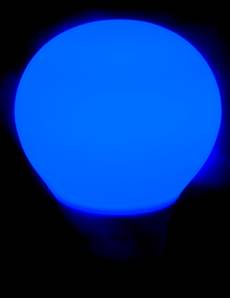
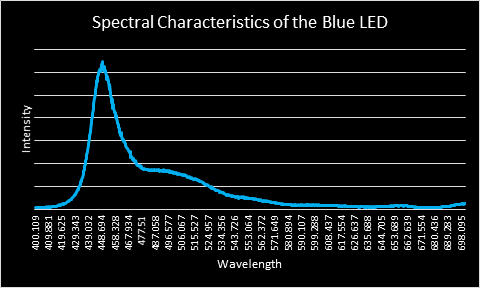
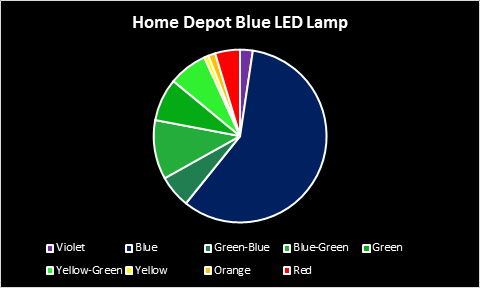
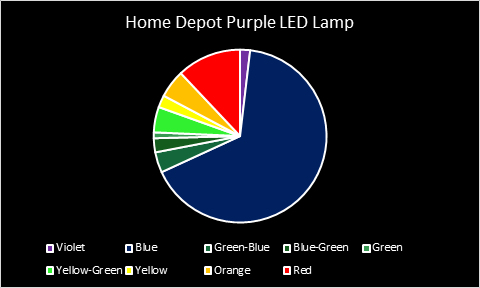

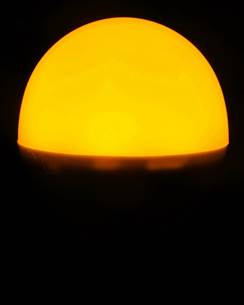
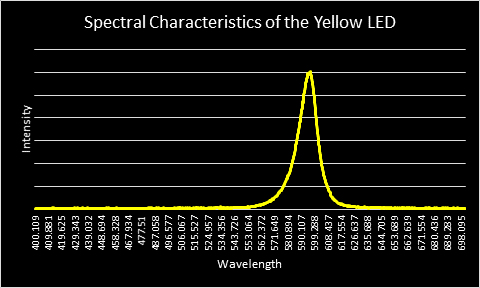
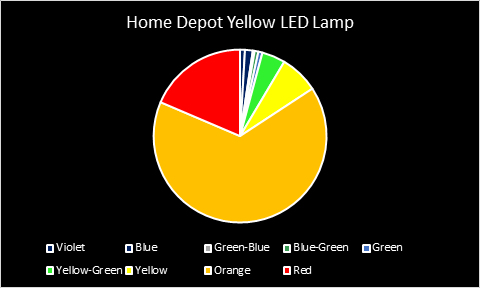
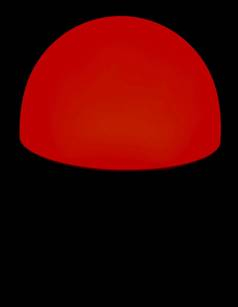
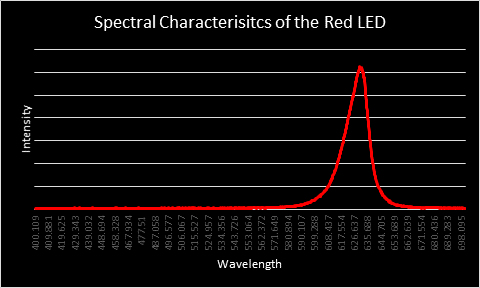
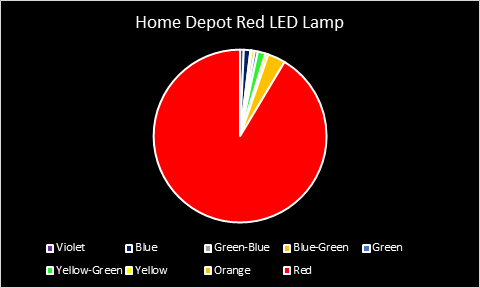
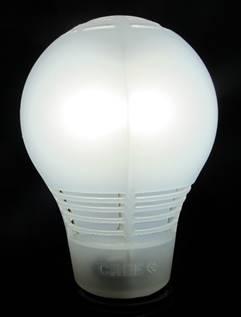
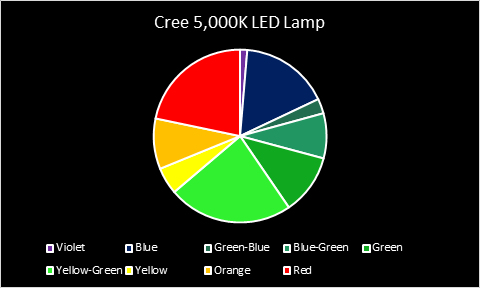
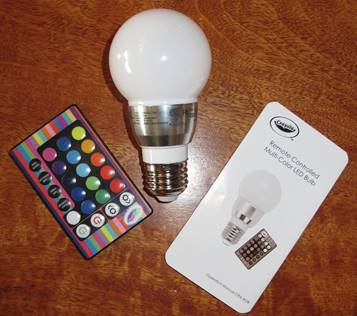
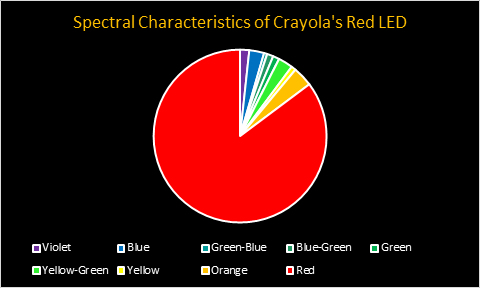

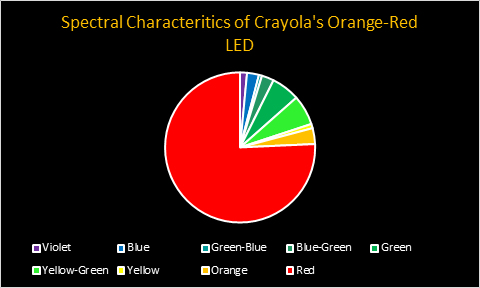

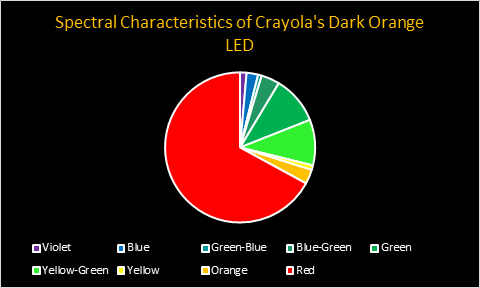
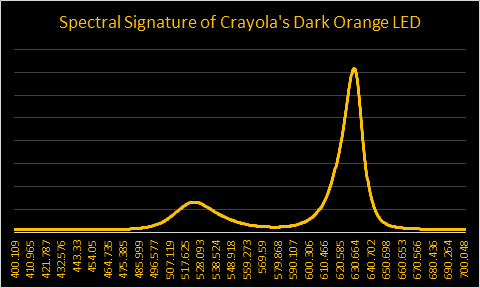

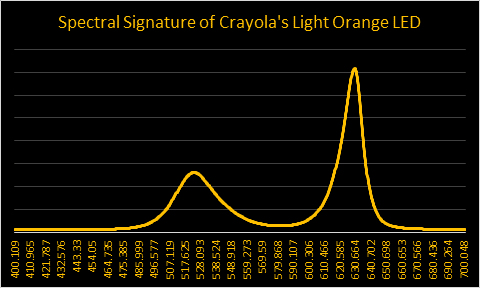



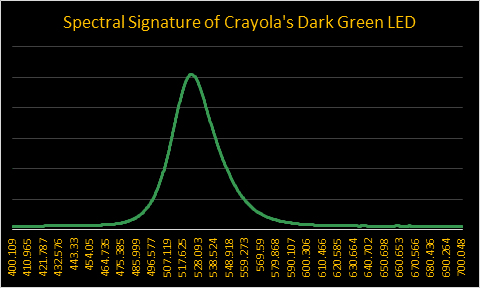
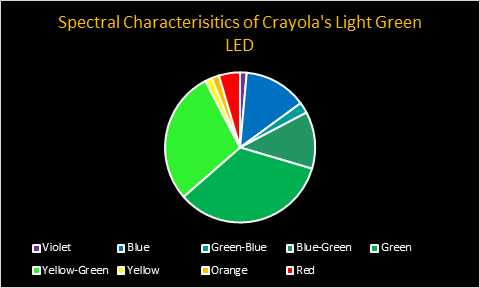
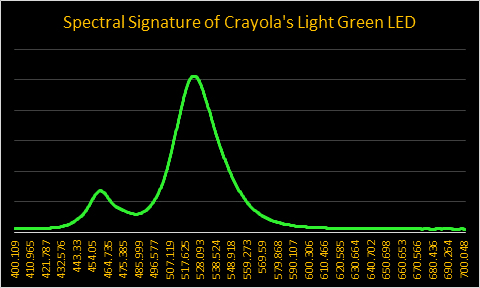
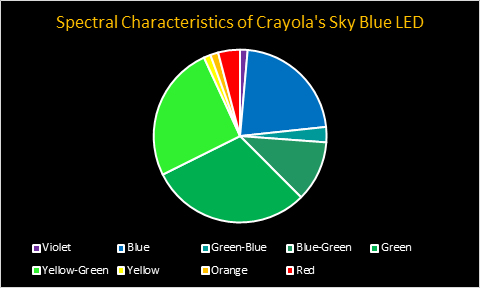
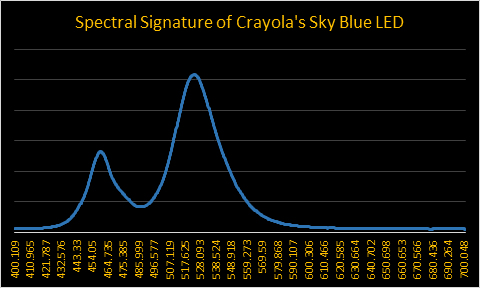
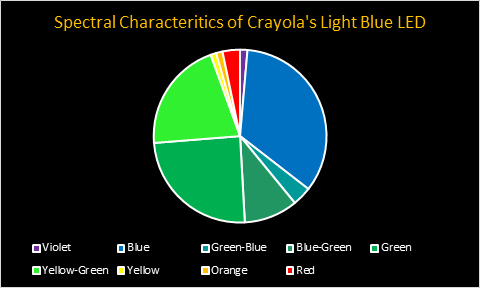
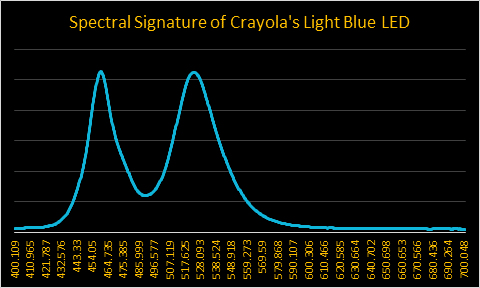
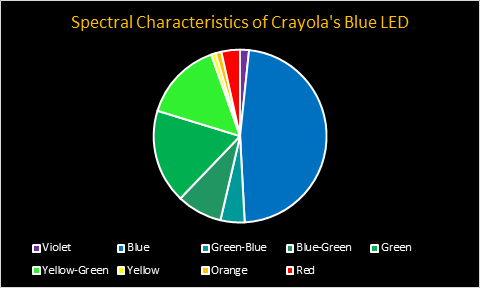
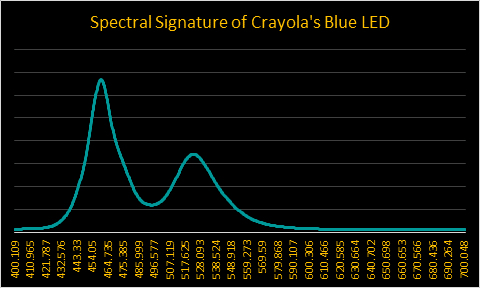
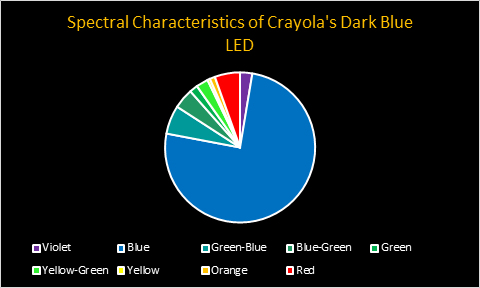
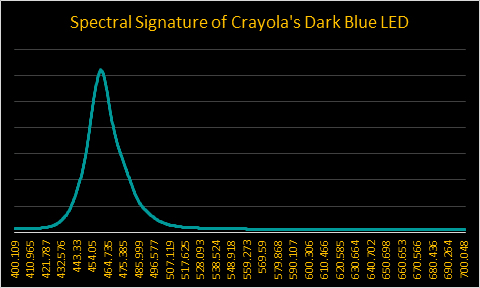
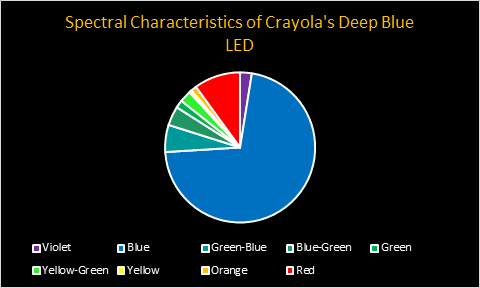
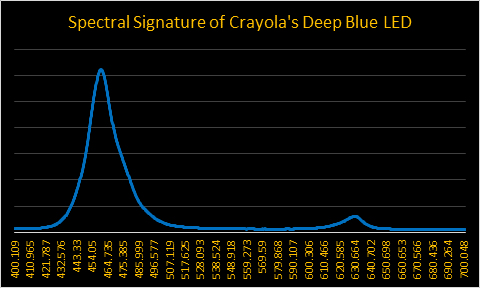
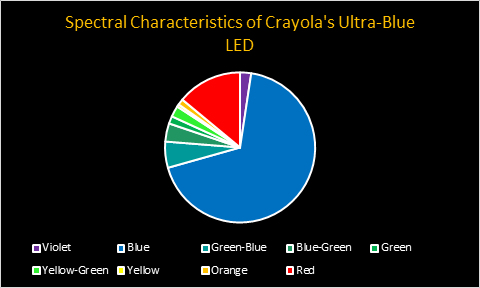
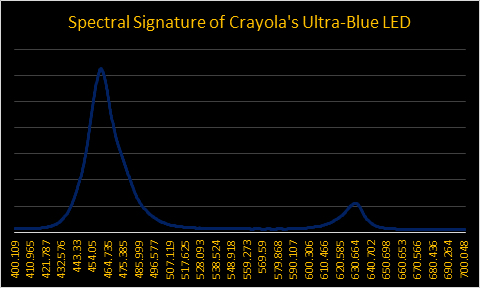
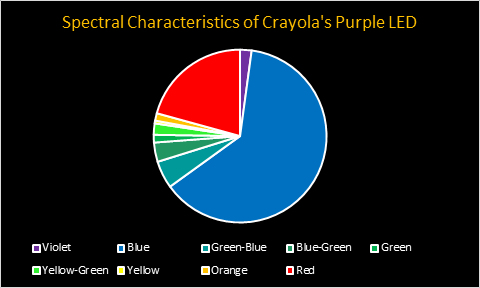
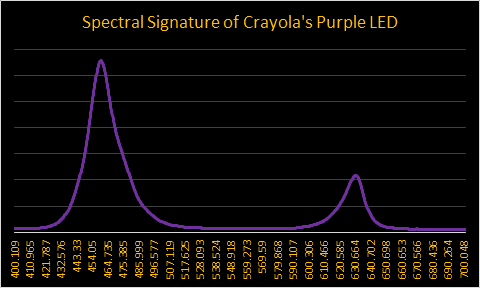
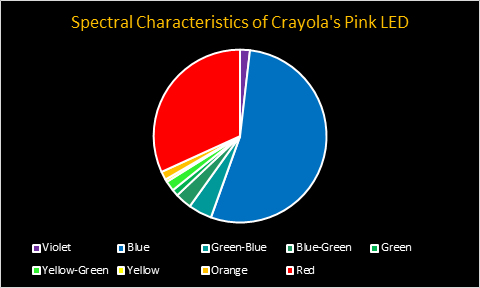
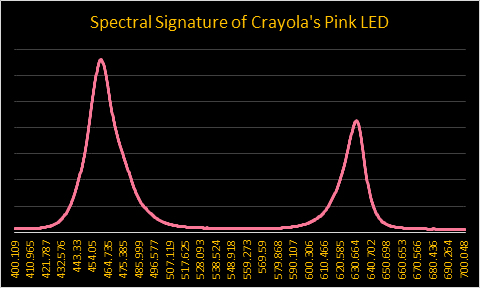
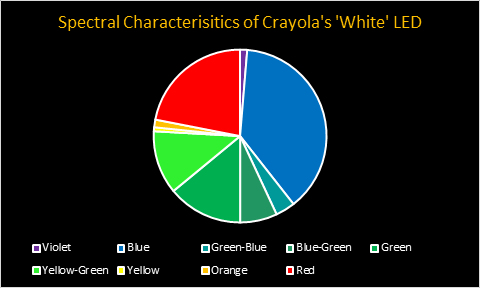
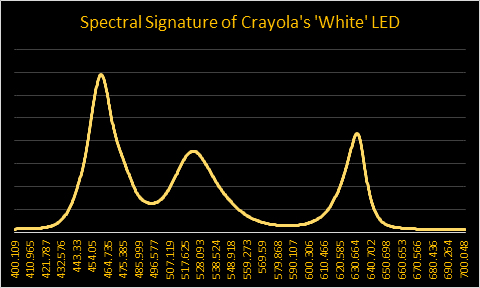
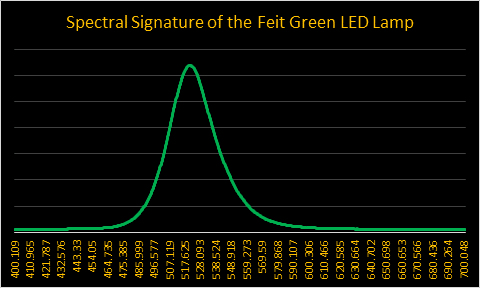
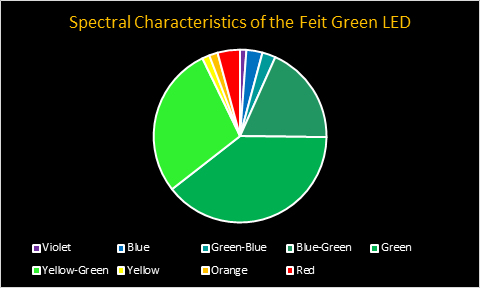
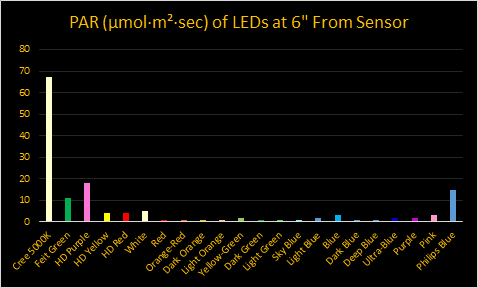

0 Comments